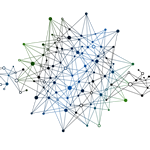 Discrete-time systems theory lays the foundation for digital signal processing algorithm development and design. This course first provides an introduction to discrete-time systems and then elucidates advanced topics in discrete-time signal processing. Topics include: (a) elementary digital signal processing (DSP): discrete-time signals and systems and their properties, z-Transform, frequency analysis, sampling and reconstruction, discrete Fourier transform; (b) multirate digital signal processing: decimation, interpolation, sampling rate conversion, digital filter banks; (c) linear Prediction and Optimum Linear Filters: linear prediction algorithms and properties, Wiener filters; and (d) adaptive filters: LMS algorithm, RLS algorithm. Discrete-time systems theory lays the foundation for digital signal processing algorithm development and design. This course first provides an introduction to discrete-time systems and then elucidates advanced topics in discrete-time signal processing. Topics include: (a) elementary digital signal processing (DSP): discrete-time signals and systems and their properties, z-Transform, frequency analysis, sampling and reconstruction, discrete Fourier transform; (b) multirate digital signal processing: decimation, interpolation, sampling rate conversion, digital filter banks; (c) linear Prediction and Optimum Linear Filters: linear prediction algorithms and properties, Wiener filters; and (d) adaptive filters: LMS algorithm, RLS algorithm. |
Learning Outcomes and Objectives
The notes and assignments on this resource page are intended to support learning of:
- advanced DSP problem solving skills
- rigorous thinking and creative visualization
- ability to overcome obstacles through ingenuity and resourcefulness
and encourage:
- an appreciation of the importance of advanced DSP for a broad class of engineering applications
- development of technical confidence
- a positive learning environment
Text Book and Relevant Sections
These course resources make use of the following text:
John G. Proakis and Dimitris G. Manolakis, Digital Signal Processing: Principles, Algorithms, and Applications, 4th edition, 2007.
The following text book sections are covered.
- Chapter 1: 1.1, 1.2, 1.3, 1.4
- Chapter 2: 2.1, 2.2, 2.3, 2.4, 2.5
- Chapter 3: 3.1, 3.2, 3.3, 3.4, 3.5.5
- Chapter 4: 4.1, 4.2, 4.3, 4.4
- Chapter 5: 5.1, 5.2, 5.4, 5.5
- Chapter 6: 6.1, 6.2, 6.4, 6.5
- Chapter 7: 7.1, 7.2
- Chapter 8: 8.1
- Chapter 11: 11.1, 11.2, 11.3, 11.4, 11.5, 11.9, 11.10, 11.11
- Chapter 13: 13.1, 13.2, 13.3
Topics and Notes
- Introduction
- Discrete-Time Signals and Systems
- z-Transform and Applications
- Frequency Analysis of Signals
- Frequency Domain Analysis of LTI Systems
- Sampling and Reconstruction of Signals
- The Discrete Fourier Transform
- Efficient Computation of the DFT: FFT Algorithms
- Intro to Decimation and Interpolation
- Sampling Rate Conversion by a Rational Factor
- Polyphase Structures, Noble Identities, and Multirate Signal Processing for Phase Shifters and Subband Coding
- Digital Filter Banks and Quadrature Mirror Filter Banks
- Introduction to Adaptive Filtering and Background
- The LMS Algorithm
- The RLS Algorithm
Problem Sets and Solutions
| Topic(s) | Problem Set Questions | Solutions |
| Introduction to Discrete-Time Systems | 1.2, 1.4, 1.6, 1.7, 2.2, 2.4, 2.5, 2.7 (a,g,j,k) | |
| Discrete-Time Analysis and the z-Transform | 2.13, 2.23, 3.6, 3.18(d), 3.23, 3.40 | |
| Discrete-Time Frequency Domain Analysis | 4.13, 4.16, 4.17,4.18,4.23, 5.4 (f,l), 5.11,5.65(a,c) | |
| Sampling and Reconstruction | 6.1, 6.10, 6.11, 6.13 | |
| DFT and FFT | 7.1, 7.3, 7.7, 7.13(a), 7.23(a,b,c,h), 7.28, 8.1, 8.3, 8.4, 8.7 | |
| Sampling Rate Conversion | 11.1, 11.2, 11.3, 11.4, 11.5 | |
| Digital Filter Banks | 11.9, 11.11, 11.12, 11.13, 11.15, 11.25, 11.29 | |
| Adaptive Filtering | 13.1, 13.2, 13.3, 13.12, 13.15 |
Note: Problem set solutions are courtesy of Julien Jainsky and Shoeb Mohammed who were former TAs for the course.
Projects
